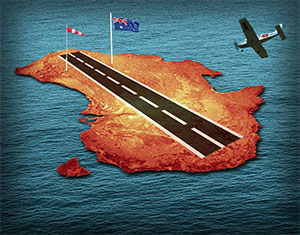Blue skies thinking

Roula Khalaf, Editor of the FT, selects her favourite stories in this weekly newsletter.
If you happen to tour parts of Australia by light aircraft, as I have just been lucky enough to do, the contrast between the free market and state subsidy is stark. South Australia, for example, is one and a half times the size of Texas, yet only 1.6 million people – a scant 8 per cent of the country’s population – live there, mostly in its capital, Adelaide. Vast tracts of the state are empty. As I flew over and landed in parts of it, I noticed that although there are pockets of capitalism in the outback, its infrastructure depends heavily on state support.
Marla, SA, has a population of about 70. Not that I met anyone when we halted there. The book on which I relied to get around says that if you want picking up at the airport you should buzz the motel – and they don’t mean use the phone. No, if I wanted collecting I should fly low over the motel and someone would come and get me.
I never met whoever was in charge of the motel, as I was flying in only to change pilot (I am alternating with Wonderful Wayne, who is travelling with me and Mr M). Marla’s airstrip has immaculate tarmac and solar lights. A sign tells visitors (of whom there must be only a few) that it was built by the government.
Next stop Oodnadatta. Here again a fabulous airstrip; here again I saw not a soul. The airstrip may be new but the derelict airport building made me sad: it looked as if once upon a time someone had loved it and cared for it. The airstrip is named after Adam Plate, who died in a car accident in 2012 after spending 38 years seeking to put Oodnadatta on the map by running the Pink Roadhouse, a pub/hotel/general store serving the embryonic outback tourism industry. Although Plate ran a successful commercial enterprise, the airstrip named in his memory, according to its sign, was built with public money.
Why is so much money spent on amazing tarmac strips and airport lighting in places where the population is so small? This liberal use of taxpayers’ money is not confined to South Australia. The solar dishes next to the airstrip in Windorah, Queensland, cost A$4.5m (£2.45m) and power a town with a minuscule population.
So I was delighted to find the free market alive and kicking in William Creek (permanent population: four). What a contrast. Here the airstrip was installed, as were the water and power, by private enterprise. One man, Trevor Wright, owns the place: besides his aviation business he also owns the pub, shop and motel/campsite.
From the moment we landed, nothing was too much trouble. Would we like fuel? A beer? A tour of his fleet? Twenty backpackers were arriving for the night; would we like to join them for a BBQ? WW asked if he could park Tango Alpha Whiskey right outside the pub – sure, no problem (see @mrsmoneypennyft for a photograph). William Creek is the face of capitalism, a revenue generator for the state, and all the better for it. But even William Creek owes its origins to state subsidy; it is a former railway town, and parts of the original line (since moved) were built under a 19th-century government unemployment-relief scheme.
There will always be disagreement between those who want to preserve the vast wilderness that is the centre of Australia and those who want to make commercial gain from it. Having seen so much tarmac installed with taxpayers’ money in so many rarely visited places, I would suggest that now that the infrastructure for aviation is there, it is time to focus on encouraging enterprise instead. That way, more people would visit and more tax dollars would be generated.
This week I will be swapping the skies for the snow at Davos and the World Economic Forum. This is one of the very rare events where politicians and businesspeople meet to discuss the issues of the day. Including, perhaps, what might be the right balance between state subsidy and private enterprise.
——————————————-
Letter in response to this article:
Airstrip there for essential services
Comments